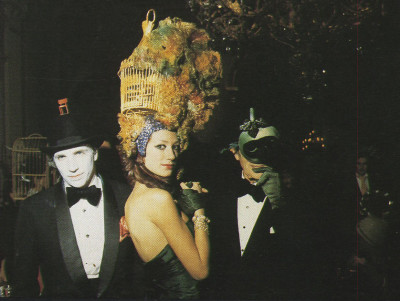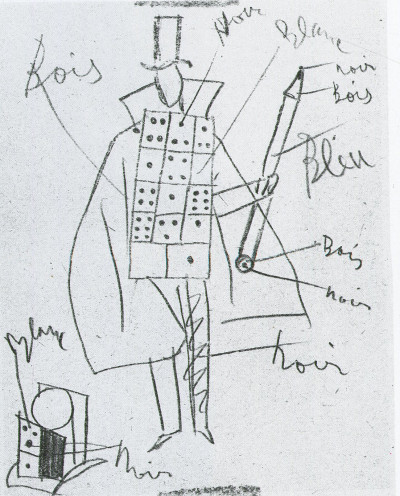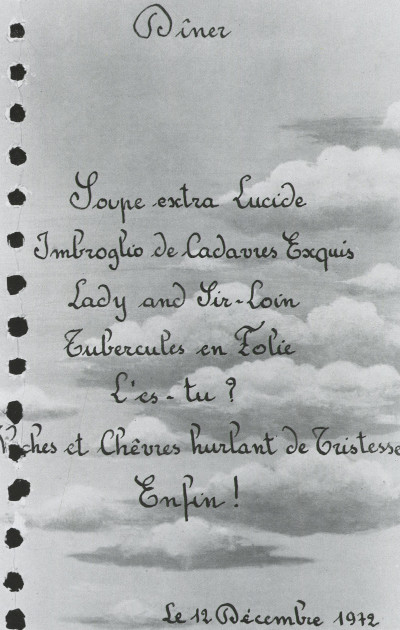From the Library: Fêtes, Mémorables Bals Costumes 1922-1972
A look at the fabulous costume balls of a bygone era
12.23.2023

One of the joys of having a big library is rediscovering favorites. Recently, I was looking for a design reference on my shelves and came upon an old love of mine: « Fêtes » a chronicle of the fabulous costume balls taking place, mostly in Paris, between 1922 and 1972 by Jean-Louis de Faucigny-Lucinge, a descendant of Louis XV and the husband of Baba d’Erlanger, one of Cecil Beaton’s favorite models. It’s an incredible collection of photographs, sketches and stories about a time, and world, that’s long gone. There were no ‘party’ photographers or personal cameras or iPhones, so the images are mostly portraits of the guests by the likes of Horst, Hoyningen-Huene, Henry Clarke and Cecil Beaton, taken upon their arrival in their incredible costumes, or sketches by their creators, which included Jean Cocteau, Christian Berard, Yves St. Laurent, Coco Chanel, Elsa Schiaparelli, Christian Dior, and on…and on. You get the sense that as fun as these balls might have been, it wasn’t so much about the party itself and more about the process of creating the elaborate costumes and the joy and ceremony of donning them.
New Year’s Eve is about looking back…and then…looking forward. And thus, we asked our dear friend Leslie Johnsen, to translate Prince Faucigny-Lucinge’s preface and decided to share with you a bit of this joyful document at a time when inspiration is most needed.
Roman Alonso
PREFACE
Entertainment of aristocratic character, rooted in Italy, consumed by allegorical, mythological, satirical or burlesque themes, with masked guests arriving accompanied by music combined with dance and poetry.
Thus is the definition listed in the Grand Larousse Encyclopédique of the word “mascarade” which might have made a good title for this book had it not possessed an unfortunate pejorative connotation. Nearly all of us have a distaste for disguise, the desire to beautify ourselves, to be transformed for one evening into a historical or fanciful character, the paradox of desiring to achieve the most flattering image of ourselves and, at the same time, becoming far different from what we normally are. But only in the case of certain eccentrics who could hardly be anything other than British, and who dressed up to dine alone in their castle in front of their servants, is a disguise made by design alone as if one becomes an actor in the “fête” that one hosts or where one is hosted.
I had the chance to play both of these roles, and it is a witness’s part that I play here, hoping to illustrate that the costume parties here mentioned were far above and beyond manifestations of frivolity and no less than socio-cultural events (if the term is not too pedantic), or in any case undisputedly privileged moments.
The tradition of costume parties, including those uniquely French, is long and prestigious. Let us consider the sinister Bal des Ardents, the ceremonial dances of King Henry III, the Court Ballets, masquerades and carousels to which the young Louis XIV attached such pride, 18c festivals inextricably associated with his image.
Should the Premier Empire, upholding such a stern façade, be exempt? When reading the fascinating work of Monsieur Charles Otto Zieseniss, Napoleon and the Imperial Court (Paris, Tallandier, 1980), the chapter entitled “Adorned and Masked Balls” tells us how many soirées were dedicated, by order of the emperor, to costumed quadrilles and allegorical “entrances” re-enacting for the most part Napoleonic victories and cease fires. Was it not Rambuteau who relayed that the great conqueror himself, attending one of these festivals, “disguising himself as a Negro leading the quadrille while blowing a trumpet!”?
One lovely souvenir from the Restoration period is the beautiful Eugène Lami leading the “quadrille of Marie Stuart” in 1829. The Second Empire welcomed the proliferation of “transvestite balls and tableaux vivants” with an invasion of the “monde” by the “demi-monde”. We cannot imagine the bizarre or even off-kilter encounters these disguises must have provoked.
With the arrival of the 20c, we could not ignore the festive frenzy of Boni de Castelane and, a new type of host, the fashion designer Paul Poiret and his “One Thousand and One Nights” in 1911.
The most remarkable costume parties which took place after the First World War - many which I attended in the joyous euphoria of my youth - were based on a theme. The choice of theme needed to be judicious. It both required and enabled the creative contribution of the most brilliant collaborators of the period.
Picasso, for example, designed a painted curtain for the “Bal des Jeux” in 1922. Other artists, like Christian Bérard or Jean Hugo, designed costumes for themselves or their friends: it was for her husband that Valentine Hugo owes the originality and fame of her marvelous disguises. In 1951, Salvador Dali along his wife Gala, protagonist of the “entry of the giants”, co-designed the Venice Ball with Christian Dior. It was not only painters who put their creativity to work for these fêtes. Couturiers like Gabrielle Chanel or Elsa Schiaparelli, later Jacques Fath or Yves Saint Laurent, all deployed their talent in creating costumes that were as beautiful as unexpected.
From the fields of music and dance, we must mention Francis Poulenc who, for the “Bal des Matériaux” (1929), composed an Aubade for 18 instruments, personally accompanying on the piano while his name was announced as an entrance. Finally, how could we not mention Serge Lifar, a passionate patron to costume parties spanning four decades, of whom I remember some spectacular entrances, like riding in on a white horse at the “Bal Champêtre” (1931), or dancing dressed as Vestris at the “Bal Racine” (1939).
The participation of writers such as Jean Cocteau, Paul Morand, René Crevel, Jacques de Lacretelle and Max Jacob was frequent. And finally, today if we can still evoke the splendor of these costume parties, it is naturally thanks to the presence of numerous photographers amidst the greatest of great guests.
Louis XIV dressed as the “Sun” for the Ballet de la Nuit (1653) Drawing from the Gissey workshop (Cabinet des Estampes, Bibliothèque Nationale, Paris)
Quadrille by Marie Stuart, 1829 Marie Stuart, represented by the Duchess of Berry, and her Court climbing the main staircase Engraving by Eugène Lami (Cabinet des Estampes, Bibliothèque Nationale, Paris)
The Princess of Metternich disguised as a “cab driver” for a performance in Compiegne Drawing by Pierre de Lano (Cabinet des Estampes, Bibliothèque Nationale, Paris)
I have gathered the names of artists and creators who contributed to the success of these one-night shows. It is an impressive list of best-in-class award winners. However, not being able to cite them all, it seems preferable to let their names appear when attending the parties here mentioned.
These endless evenings could only be successfully produced with the help of "professionals", but I need to remind you that their triumph came down to a certain number of women who, through their beauty or their elegance, were celebrities of their day. I will go out on a limb by mentioning only a few names: the Duchess of Gramont, née Ruspoli, Lady Yia Abdy, the Marquess Casati, Madame Lucien Lelong (Princess Nathalie Paley), the Countess Marie-Blanche de Polignac, the Duchess d'Ayen, Daisy Fellowes, the Baroness de Cabrol, the Marquess de Laborde (Pauline de Saint-Sauveur), Madame Edouard Bourdet, and how many others including - because I know that no one will contradict me - Princess "Baba" de Faucigny-Lucinge.
The success of these parties was also, above all, due to the vigorous and keen participation of those invited or those potential candidates (as during these times, attendance could not be "required" by order of the sovereign).
One needs only imagine the sorts of anxieties which guests might find themselves subjected to:
- “I haven't received my invitation yet. Will I be invited?”
- “What will I wear?”
- “Who will I make my entrance with?”
But to call these agonies laughable would be to confess a lack of appreciation for the writings of Marcel Proust.
Was there fun to be had at these costume parties? There were moments of formidable delight, many for example still remembered with glee by those guests in attendance of the “Bal de La Lune sur Mer” hosted by the Noailles. There were also, of course on occasion, lulling moments during the festivities. But the excitement of preparing for the party and the buzz of commentary that followed often surpassed that of the event itself. In the end, the most difficult role was that of the organizers, who, with genuine creative talent, orchestrated the preparations and oversaw the running of the “fête” timed to a tee.
The chosen location of the party was key. It could be the customary residential home or the choice of a more out of the ordinary venue, beautiful or original as long as it was not too shabby.
Then there was the rather thorny matter of the guest list where a subtle balance required striking between friends and relations on one hand, and talented and renowned personalities on the other. One had to take the inevitable risk of triggering disappointments and lasting animosity.
And financial means should not be overlooked, but they were not necessarily immense. Boldness and a sense of improvisation or even an all-hands-on-deck approach could provide successful results. Remarkable costumes did not always require unreasonable expense whereby imagination and humor often prevailed over pomp. The photographer Man Ray, protagonist of many pre-war balls, reported this way about an important ball hosted by the Noailles:
In the end, I made one (costume) out of a shiny rayon laundry bag. To accommodate my arms and feet, I cut holes in the four corners. I also wore a beret on which I had attached a tiny spinning reel. I carried an eggbeater in my hand. My costume was more Dadaist than Futurist. Compared to other fancy dressed guests at the ball, I looked quite scruffy; aluminum outer space suits, an evening gown and sharkskin hat for the hostess. I was not, however, disappointed by myself, and I dipped into the Champagne dinner that went on late into the evening convinced that my costume was as original as the others even if it cost less. I also found my appearance to be a sort of protest against the extravagance I witnessed around me; and effective, judging by the sideways glances some guests shot my way.
Man Ray, excerpt from Self-Portrait, Paris (Robert Laffont) 1964
Let us please recall another anecdote about preparations being made near Marseille at the Château de Montredon in 1942, of the reincarnation of A Midsummer Night's Dream at the home of Countess Pastré. Christian Bérard, in charge of décor and costumes, lamented over a lack of fabric: “We could have used something resembling the red curtains in your living room.” “Well, let’s tear them down!” responded Madame Pastré.
It was of ultimate necessity therefore to marry tact with diplomacy, fortitude with tenacity, a spirit of decision making and organization, enthusiasm and an insatiable hunger to celebrate.
Suffice to say that the people we are talking about could never be considered banal. I would be glad if the “souvenir portraits” taken (to borrow this lovely expression from Jean Cocteau) were proof that those in attendance were anything but.

























































